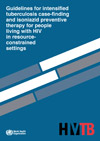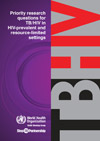TB/HIV in Prisons
"All prisoners have the right to receive health care, including preventive measures, equivalent to that available in the community" World Health Organization,1993
TB/HIV is a major threat to prison health with HIV rates as high as 50%, TB incidence rates on average 23 times higher than in the general population [i], higher rates of TB drug resistance [ii] and much higher death rates. Furthermore, HIV is a key reason for latent TB in prisoners progressing to active disease [iii] and TB is the greatest cause of death among people living with HIV. Overcrowding, limited sunlight, absence of TB and HIV infection control measures, combined with late case detection and the absence of harm reduction, preventive therapy and timely treatment all contribute to a highly infectious environment. Compromised immunity due to factors such as poor nutrition, alcohol and/or drug use will also result in a higher risk of developing active TB. International human rights law clearly defines states obligations to protect prisoner health [iv], however access to TB and HIV prevention, diagnosis and treatment in prisons is frequently denied.
TB, HIV and drug use in prisons - a complex relationship Populations most at risk of HIV and TB are often the more marginalized and more likely to be imprisoned. People who use drugs are one such example [v], and once in prison they are more at risk of contracting HIV than drug users not incarcerated. [vi] [vii] Drug use is also an independent risk factor of TB, regardless of HIV status. [viii] [ix] [x] With the higher inter-related risks, it makes no sense to address each condition in isolation. Evidence supports a comprehensive package of care, comprising harm reduction and collaborative TB/HIV activities that ensure prevention, and timely diagnosis and treatment of TB and HIV.
Multi-sectoral co-ordination is essential At any given time the global prison population is about 10 million with an annual total of more than 30 million, and considerable migration back and forth to the community. One in eleven and one in sixteen TB cases occurring in the community in high and mid-low income countries, respectively, have been found to be as a result of TB transmission within prisons [xi]. A strong multi-sectoral approach is therefore needed with clearly defined roles and responsibilities, that hold actors accountable. Such an approach will not only ensure continuity of care between the prison and the civilian sectors but it will also encourage an equivalence of care that pays due respect to human rights.
Key guidance documents to address TB/HIV in prisons
 Guidelines for the Control of Tuberculosis in Prisons
Guidelines for the Control of Tuberculosis in Prisons
 WHO Policy on TB Infection Control in Health-Care Facilities, Congregate Settings and Households
WHO Policy on TB Infection Control in Health-Care Facilities, Congregate Settings and Households
Further resources:
African HIV in Prisons Partnership Network
WHO Europe - Health in Prisons Project
 Policy Guidelines for Collaborative TB and HIV Services for Injecting and Other Drug Users - An Integrated Approach
Policy Guidelines for Collaborative TB and HIV Services for Injecting and Other Drug Users - An Integrated Approach Implementing the WHO Policy on TB Infection Control in Health-Care Facilities, Congregate Settings and Households: A framework to plan, implement and scale-up TB infection control activities at country, facility and community level
Implementing the WHO Policy on TB Infection Control in Health-Care Facilities, Congregate Settings and Households: A framework to plan, implement and scale-up TB infection control activities at country, facility and community level



 Intensive case finding and isoniazid preventive therapy guidelines, 2010
Intensive case finding and isoniazid preventive therapy guidelines, 2010
 Priority research questions for TB/HIV in HIV-prevalent and resource-limited settings, 2010
Priority research questions for TB/HIV in HIV-prevalent and resource-limited settings, 2010